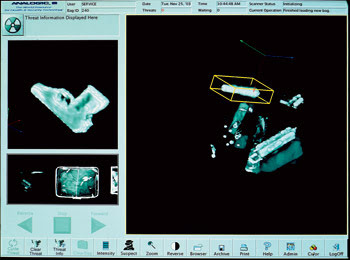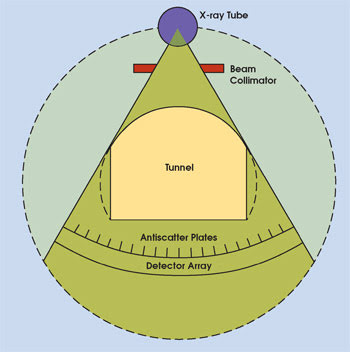A 3-D computed tomography system automatically screens luggage for explosives and weapons.
David Schafer, Analogic Corp.
Ensuring the safety of airline passengers has created a demand for larger, more robust security devices at baggage check-in sites. Previous x-ray systems could scan baggage but could neither detect three-dimensional objects nor automatically discern the difference between a hair dryer and a firearm or a potential explosive device.
Using technology that now provides and interprets 3-D images for more accurate assessment of luggage and cargo, Analogic Corp. developed an x-ray system comprising a dual-energy high-voltage power supply, an x-ray tube and a detector array.
The system is mounted on a gantry that rotates around a baggage conveyor. Luggage moves continuously on the conveyor belt past the rotating x-ray beam/multirow detector array, producing a collection of projections taken at many angular positions around the bags. The data is then reconstructed employing helical-cone beam-computed-tomography (CT) algorithms to produce sequential axial images that are stacked to create a 3-D image of the contents of each bag.
Sophisticated automatic detection algorithms search the bag image data for weapons and explosives, while 3-D images are shown on a screener’s workstation. If a threatening item is detected, it is highlighted for the operator, and the object image is extracted into its own, smaller viewing window (Figure 1).

Figure 1. Detection algorithms search the luggage image data, and 3-D images are shown on the workstation display.
X-ray optics
The combination of x-ray positioning, focal-spot size, collimating optics and detector-array geometry determines the imaging characteristics of the scanner, defining the available image resolution (Figure 2).

Figure 2. An x-ray source, a detector and collimation are used to define the beam optics in the scanner.
X-rays are produced in a bremsstrahlung tube at 140 to 180 kVp. The x-rays are emitted from a focal spot located where an energized electron beam strikes the target inside the tube. The x-ray focal-spot size depends on the power required, typically in the range of 0.6 to 4.0 mm2.
This finite focal-spot size limits the spatial resolution of the imaging device. The x-rays must pass through the materials in the tube surroundings, which can include glass or various metals. Higher-energy x-ray photons have a higher probability of passing through the tube walls, while lower-energy x-rays are attenuated.
The emitted x-ray photons travel through the scanner tunnel, interacting with the material in the suitcases on the conveyor belt. X-rays generally interact with the baggage by photoelectric absorption or by Compton scatter. Both interactions reduce the intensity of the x-ray beam. Photoelectric absorption removes the x-ray photon entirely, while Compton scattering results in a scattered, lower-energy photon.
The photons, if detected, result in image artifacts. To reduce the artifacts, x-ray-attenuating material is placed in the beamline and refocused to the x-ray source focal spot. X-ray photons that are scattered from outside of the acceptance angle of the antiscatter plates are attenuated in the plates and not detected.
X-ray photons that are neither scattered nor absorbed will strike the detector array. The detector system is composed of CdWO4 scintillator crystals arranged in a 2-D array. When an x-ray photon is absorbed or scattered in the scintillator, the crystal emits characteristic visible light.
Crystals are designed to have total internal reflection on all surfaces, with the exception of one surface that is optically coupled to a silicon photodiode. Signals from the photodiodes are directly transmitted to the data-acquisition system via a multilayer printed circuit board or cables. The data-acquisition system uses ultralow-noise analog circuitry combined with analog-to-digital conversion to produce a digital reading for each detector output at each sample position.
The x-ray detector also limits the spatial resolution of the system. The size of these detectors is specifically chosen to image contents of the baggage for use in automatic detection. Smaller detector elements can result in higher-resolution images. Other factors, including sampling interval, conveyor speed and reconstruction algorithm mathematics, contribute to the final image resolution.
Proper design of the x-ray beam-line is critical to a successful CT scanner. The beam optics encounter a combination of the focal spot, collimators, detectors and x-ray scatter. These components must be chosen based on the application for the particular scanner.
Scanning the future
Experience and inventions in the areas of x-ray optics, detector physics and high-precision signal processing have driven the development of novel security technology that is currently screening thousands of bags every day in many airports, improving aviation security for everyone. Modifications for different aperture sizes and conveyor speeds will lead to screening systems for carry-on bags, mail and air cargo.
Meet the author
David Schafer is vice president for explosive detection systems in the Security Systems division of Analogic Corp. in Peabody, Mass.; e-mail: [email protected].